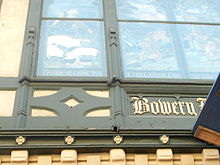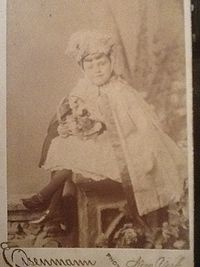Charles Eisenmann
Charles Eisenmann | |
|---|---|
 Cabinet card of Eisenmann, verso | |
| Born | October 5, 1855 |
| Died | December 8, 1927 (aged 72) |
| Nationality | American |
| Education | W. W. Washburn in New Orleans |
| Known for | Photography |
Charles Eisenmann (October 5, 1855 – December 8, 1927) was a famous New York photographer during the late 1880s who worked in the Bowery district.[1]
Eisenmann's photography was sold in the form of Cabinet cards, popular in this era, available to the middle class. Eisenmann also supplied Duke Tobacco Company with cheesecake photography to stuff in their tobacco cans. The book Victorian Cartes-de-Visite credits Eisenmann with being the most prolific and well known photographer when it comes to Cabinet cards.
His work was the subject of a 1979 monograph, Monsters of the Gilded Age, focusing on his work on human oddities from the Barnum and Bailey circus, with a notable widely circulated picture of Jojo the Dog-faced Boy.[2] Although a number of his photographs were of obvious fakes (called "gaffed freaks"),[3] many others were genuinely anomalous, including the giant Ruth Goshen, the four-legged girl Myrtle Corbin, and the Siamese twins Chang and Eng and Millie and Christine.
Bowery district

The address was 229 Bowery, which now is the home of a ministry and recently underwent a 3 million dollar renovation.[4] At the time the Bowery district was an eclectic mix of artists, transient people and prostitutes.[5] The depiction of this area in the movie Gangs of New York is judged by experts to be fairly accurate.[6] The fallout of the New York City draft riots would have made for an era in New York that was unbridled and experimental: an ideal setting for unusual and cutting-edge photography.
Humbugs
In his book, Secrets of the Sideshows, Joe Nickell points out that Eisenmann used a number of notable humbugs or gaffs. These included his "Circassian beauties", women with teased, large hairdos who were said to have escaped from Turkish harems. The models were locals from the Bronx with hair made frizzy and wild by washing in beer, who earned money for posing.
Victorian society and circus freaks


In the late 1880s, A new phenomenon appeared with Victorian society's fascination and sympathy for people who appeared to have genetic abnormalities. There was much publicity, for example, over Princess Alexandra's attention to Joseph Merrick, the "Elephant Man."
Eisenmann saw the golden opportunity in this fascination, and photographed circus people dressed as Victorian society, and conversely Victorian society with circus props. In New York city circus people were quite well received, as evidenced by the proliferation of dime museums and the PT Barnum circus located in New York.
One of Eisenmann's subjects, Charles Stratton (Major Tom Thumb) was quite well known, and his wedding was quite the affair. "The couple’s elaborate wedding took place in Grace Episcopal Church in New York City. The Astors and the Vanderbilts were said to have attended as Barnum sold tickets for $75."[7]
Other prestigious clients included Mark Twain, and Annie Oakley. In some ways Eisenmann can be considered a kind of Annie Leibovitz of the Victorian Bowery district. His career suffered a downturn with the introduction of Gelatin silver process photography which made photographs more inexpensive and available for mass consumption.[8] Also, Vaudeville overtook circuses in popularity at this time as well. In 1898 Eisenmann closed his studio and was succeeded by Frank Wendt.[9] Frank was a sort of intern of his.[10] For a few years, he sold photographic equipment and took conventional portraits in Plainfield, New Jersey but by 1907 he had disappeared from the public record,[11] some believing he went to Germany. This was the second time he went off the radar, the first time being when his first wife died. At that time he was believed to have gone to Asia.
Eventually, in the early 1900s, he resurfaced as the head of the photography department for DuPont taking pictures of employees. He died in 1927.[8]
A collection of his photographs was auctioned off through Sotheby's in 1991, with an estimated price of between $15,000 and $25,000 for the large collection.[12]
In popular culture

A number of Eisenmann's favorite subjects can be seen depicted in The X-Files episode "Humbug", namely Jojo the Dog-faced Boy and Chang and Eng Bunker.
Contribution to medicine
A number of Eisenmann's pictures have been catalogued for their depiction of a number of mutations and abnormalities.[13]
References
- ^ Ephemeral New York (blog), "A Bowery photographer’s freak show portraits", September 8, 2011. Accessed on March 17, 2012.
- ^ Artnet, "JOJO: The Russian Dog Face Boy by Charles Eisenmann". Accessed on March 17, 2012.
- ^ Dennis Gaffney, "Who Were the Circus 'Freaks'?", Antiques Roadshow, PBS, 2006. Accessed on March 17, 2012.
- ^ Places that Matter, Bowery Mission, 2011. Accessed on March 17, 2012.
- ^ David Chesanow, "Collector spotlight: Arthur Farrell, collector of Charles Eisenmann photos", American Collector, April 30, 2011. Accessed on March 17, 2012.
- ^ Fergus M. Bordewich, "Martin Scorsese’s Meanest Streets Yet: Rediscovering the 19th Century Gangs of New York, originally appeared as "Manhattan Mayhem" in Smithsonian, December 2002. Accessed on March 17, 2012.
- ^ Zosha Stuckey, "Staring Back: The Rhetorical Fitness and Self-fashioning of Ann E. Leak and Lavinia Warren, 19th Century Side Show Performers" Archived February 9, 2011, at the Wayback Machine, Enculturation: a journal of rhetoric, writing and culture, November 2010. Accessed on March 17, 2012.
- ^ a b Colleen Fitzpatrick, "Who? what? When? Where? Why? A Photo Puzzle Case Study" (PDF), Games Magazine, Forensic Genealogy, November 2008. Accessed on March 17, 2012.
- ^ "Chas. Eisenmann & Frank Wendt : Steven Bolin's Vintage Collection :". stevenbolin.com.
- ^ "Getting Freaky in Boonton, NJ in Weird Announcements Forum". Yuku.
- ^ Mitchell, p. 26
- ^ Artnet, Charles Eisenmann - Past Auction Results, October 9, 1991. Accessed on March 17, 2012.
- ^ Anne Marie Todkill "Anomalies and anonymity", Canadian Medical Association Journal, August 24, 1999. Accessed on March 17, 2012.
Further reading
- Michael Mitchell (1979). Monsters of the Gilded Age: The Photographs of Charles Eisenmann. Toronto: Gage Pub. ISBN 0-7715-9521-2. Republished in colour edition by ECW Press in 2002.
- Robin Wichard and Carol Wichard, Victorian Cartes-de-Visite, Osprey, 1999
- Joe Nickell, Secrets of the Sideshows, The University Press of Kentucky, 2005
External links
- The Ronald G. Becker Collection of Charles Eisenmann Photographs at Syracuse University
- Vintage Sideshow Photography (website): Charles Eisenmann
- Gallery Naruyama, Japan Maintains a collection of over 300 images by Eisenmann.
- Webarchive template wayback links
- Articles with short description
- Short description is different from Wikidata
- Articles with hCards
- Commons category link from Wikidata
- Articles with FAST identifiers
- Articles with ISNI identifiers
- Articles with VIAF identifiers
- Articles with LCCN identifiers
- Articles with PIC identifiers
- Articles with TePapa identifiers
- Articles with SUDOC identifiers
- Photographers from New York (state)
- 1855 births
- 1927 deaths
- Immigrants to the United States